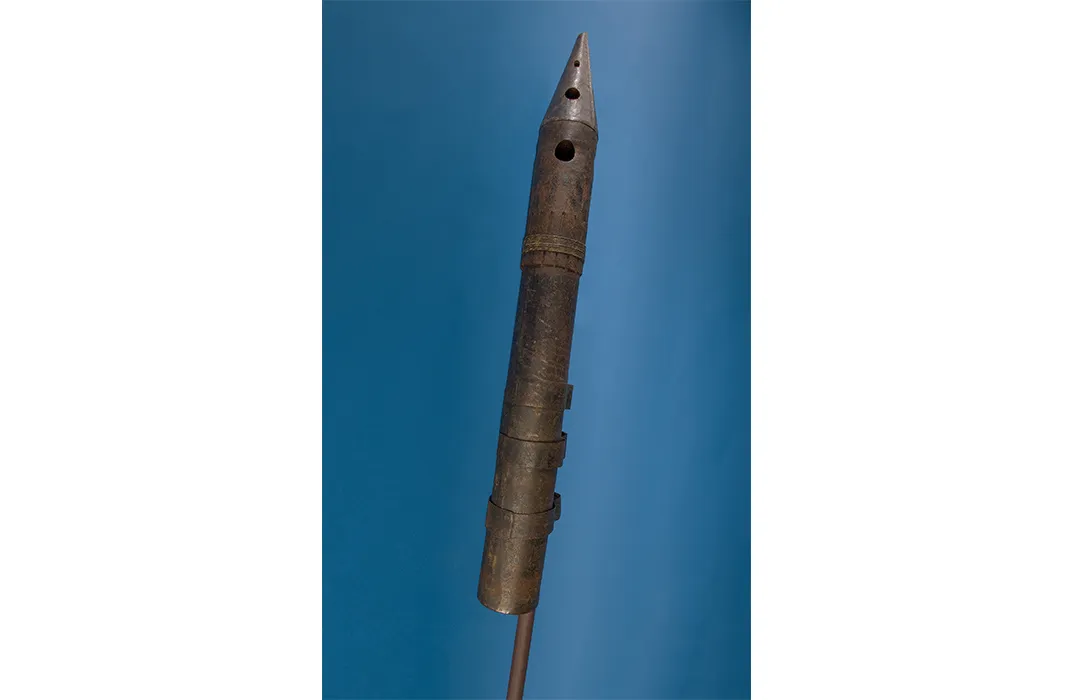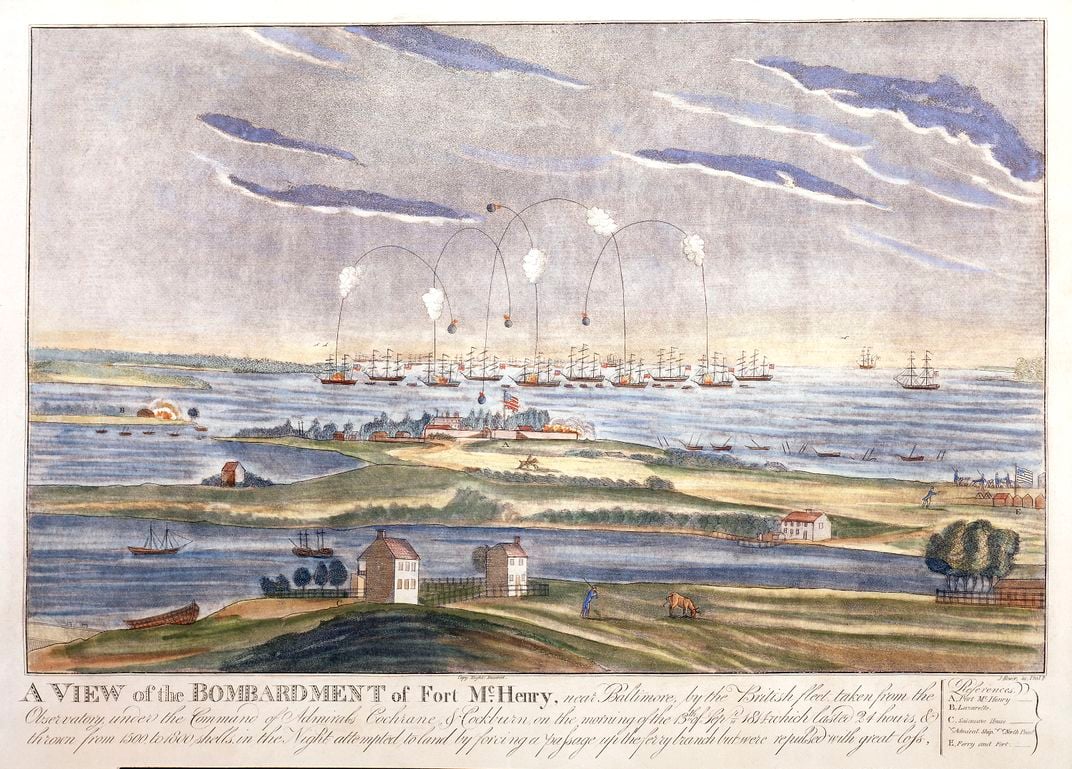The Rockets That Inspired Francis Scott Key
We know they had a “red glare,” but what kind of rocket did the British fire in 1814?
/https://tf-cmsv2-smithsonianmag-media.s3.amazonaws.com/filer/bf/72/bf7241f1-fef2-4b2f-b4f8-1edb94a1aa76/16b_sep2014_ssbcomposite08_live.jpg)
All Americans know these words: “And the rocket’s red glare, the bombs bursting in air, gave proof through the night that our flag was still there.” The line has a special meaning to me, as the former curator of rocketry at the National Air and Space Museum, because the rockets that inspired Francis Scott Key to write what would become the national anthem represent one of the foundations of modern rocketry. Two hundred years ago this month, Key witnessed the British fleet launching the rockets over Baltimore Harbor during the battle for Fort McHenry, an historic victory that interrupted a string of U.S. defeats during the War of 1812. Today, on the National Air and Space Museum website, you can see a replica of the type of rocket the British used in the battle for Baltimore and throughout the war. The model was given to the Museum in 1976, a birthday present from the Science Museum of London.
The rockets were the brainchild of the highly inventive William Congreve, who happened to be the son of a British lieutenant general of the Royal Artillery. The younger Congreve devised them, beginning in 1804, as a means of destroying Napoleon Bonaparte’s fleet, then threatening to invade England. Before Congreve began his experiments, the basic rocket was no more than a conveyance for fireworks. A rocket was sometimes used to send signals. Even though the technology was a thousand years old—it had probably originated in China—it had hardly changed from its beginnings. Propelled by gunpowder, rockets had a range of barely a few hundred feet and were wildly unpredictable in flight. Congreve improved their effectiveness by increasing their size, compacting the gunpowder more tightly in brazed-iron cylinders, and devising a variety of warheads. He also calculated the most effective angle of launch. He increased the ranges up to 3,000 yards (more than 1.7 miles), though flight paths were still unpredictable and the weapons were far from accurate.
Congreve first experimented with cardboard-cased fireworks types known as “skyrockets.” He then created a series of larger models with iron bodies, from the smallest six-pounder shell in a spherical explosive warhead to a monster with a diameter of 18 inches. The 18-inch-caliber rocket, weighing nearly 300 pounds, was incendiary, intended to burn the wooden ships of the day or to set fires inside forts. It was expensive to make and cumbersome to carry into battle, so it remained experimental. A 3.5-inch-diameter 32-pounder was the most favored size—and the kind fired against Fort McHenry on September 13 and 14, 1814. It carried seven pounds of incendiary mixture.
From 1806, Congreve rockets were widely employed against Napoleon’s forces on both land and sea, with varying success. Congreve had even devised launching racks (he called “rocket frames”). In 1809, he built his first rocket-firing ship, the Golago, which sailed against Napoleon’s fleet off the Dutch coast. It was his second rocket-firing ship, the Erebus, under the command of Captain David Ewen Bartholomew, that was sent against Fort McHenry.
The Erebus was a converted 18- or 21-gun sloop. The ship’s logbook, which still exists, reveals that in April 1814, before setting sail to America, Congreve himself came aboard to inspect the rocket “scuttles,” square openings for launching rockets, 10 on each side of the ship below the main deck. Each rocket could be aimed up to a 55-degree angle, because Congreve found that the angle that offered the maximum range lay between 50 and 55 degrees. The rocket was stabilized in its flight not by fins but by a 15-foot wooden pole, or “guide-stick,” secured to the body by a pair of metal brackets. The longer and stronger guide-stick was one of Congreve’s innovations.
For the Chesapeake campaign, which led to the bombardment of Fort McHenry, Royal Marine Artillery troops fired 12-pound rockets to harass American towns up and down the coast and even burn down houses. The Erebus also stowed 12-pounders to fire at coastal targets. An exhibit at Fort McHenry includes a Congreve rocket’s iron body recovered from the ruins of a farmhouse, owned by Henry Waller on Maryland’s Eastern shore and destroyed by rockets on August 28, 1814. Ironically, in 1831, Waller’s claim for compensation for war damages by the enemy was won in Congress by a Georgetown lawyer Waller had hired—Francis Scott Key.
Congreve rockets were the terror weapon of the war, and the British deployed them widely in the United States, from Maine to New Orleans. (They were also used in battles fought in Canada.) In late August 1814, Congreve rockets had so terrified the untrained recruits at the battle of Bladensburg, Maryland, that they fled upon hearing the terrible hissing sounds of the burning rockets that flew wildly toward them. President James Madison and a few of his Cabinet members watched the scene on horseback from a few feet away; then they too wisely fled. The rockets were also partly to blame for the fire that consumed all but the outside walls of the “President’s Palace” (as the White House was called in 1814). According to contemporary reports, rockets were aimed into the stacks of law books and other combustibles that had been piled against the building.
And how did Congreve’s rockets fare at Fort McHenry? Here, the British were not so lucky. Captain Bartholomew attempted to deluge the fort—600 to 700 rockets were fired over the 25-hour assault—but the defending American guns were too brisk. The Erebus could not get close enough, and the rockets fell short, and into the bay. They may still lie deep beneath the waters not far from Fort McHenry. And as for producing a “red glare,” that was unlikely. As they snaked toward their targets, the rockets emitted gray smoke trails, and their exhaust flames—orange, not red—were almost certainly not visible from a distance.
Throughout the nearly three years of war, Congreve’s rockets were known to have killed only three people, but they had an impact on the future of warfare. After the rockets were introduced by the British, dozens of other countries formed their own rocket troops and rocket establishments. Fred Durant, a distinguished historian of rocketry and my first boss in my 39-year career at the Museum, always maintained that you cannot tell the history of rocketry without discussing Congreve rockets, and he was determined to acquire one of them for the Museum’s collections. As crude as it may seem today, the Congreve rocket was unquestionably a significant ancestor of the powerful rockets and missiles in today’s arsenals.

